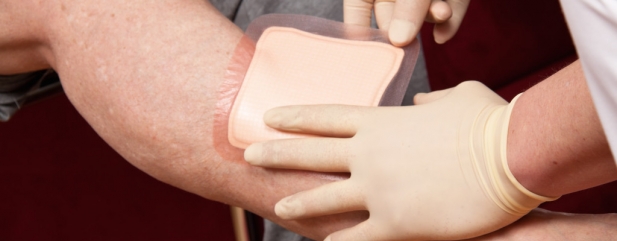Archived article
Please note that tax, investment, pension and ISA rules can change and the information and any views contained in this article may now be inaccurate.
ConvaTec enters FTSE 100 seven weeks after IPO

Monday 19 December will see a relatively unknown company enter the FTSE 100. Wound care technology company ConvaTec (CTEC) will officially join the blue chip index a mere seven weeks after floating on the UK stock market.
FTSE 100 tracker funds will be forced to buy the stock to have an accurate representation of the index. The £4.88bn company has already seen decent demand from investors as the shares have gone from 225p at IPO (initial public offering) on 31 October to now trade at 242p.
WHAT DOES IT DO?
Reading-based ConvaTec was founded in 1978 and employs around 9,000 staff across more than 100 countries.
It makes medical products, such as specialist wound care dressings, colostomy bags, catheters and skin care ware.
The company has emerged as one of the dominant suppliers in each of its specialist markets; number two and three respectively in the US and EU for Advanced Would Care and Stoma/Ostomy care products, the descriptive term for colostomy and related conditions. That’s according to research by several analysts.
It is operating in a growing market driven by ageing populations which are increasingly suffering from prolonged chronic health problems. In many cases, patients that begin using its products then do so for life, creating what should be high levels of recurring revenue.
In the year to 31 December 2015, ConvaTec generated $1.65bn revenue, on which it made an adjusted operating profit of $437m. In the first six months of this year, the company had revenue of $826m.
PROS AND CONS
ConvaTec is either a turnaround story or a high-visibility, long-duration healthcare growth story, depending on your point of view.
Either way, there is a rarity element attached to the story after years of healthcare industry M&A that has created a relative scarcity of global healthcare stocks with the scale and liquidity to match.
ConvaTec was a private-equity owned enterprise prior to its IPO. Both Nordic Capital and Avista Capital remain substantial shareholders with circa 45% and 19% stakes respectively.
It seems to have suffered from a degree of under-investment in the past. Back in 2014 analysts at investment bank UBS identified the company’s ‘lack of a direct-to-consumer marketing programme’ for its Stoma/Ostomy lines, and flagged an apparently under-staffed sales force, presumably both factors in a history of declining market share and profit margins.
That situation started to change after new management was installed in December 2014, led by current chief executive Paul Moraviec.
An independent strategic review in March 2015 highlighted the potential to add 300 basis points, or 3%, to earnings before interest, tax, depreciation and amortisation (EBITDA) margins from 29% in 2015 to 32% by 2020.
MIP’d in the bud
To achieve this goal ConvaTec plans to consolidate manufacturing from 11 plants down to eight by the end of 2017, which it says will allow for cost reduction equivalent to 3% of sales. That will presumably save about $50m a year.
Analysts predict scope for improving operational efficiency, too. For comparison, Danish peer Coloplast reported EBITDA margins of 36% in 2015, according to Peel Hunt.
Savings from the company’s Margin Improvement Plan (MIP) and other operational efficiencies are also expected to support cash generation.
Clear thinking and strong action will be needed to meet its cost savings targets without capping growth opportunities, while substantial sales force investment will add to costs.
New product lines will help growth, such as Avelle, a 30-day disposable wound patch aimed at the estimated $111bn a year Negative-Pressure Wound Therapy market. Its chief competitor is believed to be Smith & Nephew’s (SN.) seven-day NPWT plaster, Pico.
Lastly, one of the chief reasons to float was to slash ConvaTec’s mounting debt pile, which was believed to top £3.3bn last year. That’s equal to an eye-watering seven-times 2015 EBITDA. Post IPO, borrowings should have been roughly cut in half thanks to raising £1.46bn at the float.
Pricing pressure
Beyond internal factors there is also stiff pricing pressure across the healthcare industry – a factor that is not restricted to pharmaceutical budgets.
ConvaTec itself is guiding towards an annual negative pricing impact of 1% across each of its product franchises, while government healthcare reforms could put an even greater squeeze on the company.
Investment in the business is widely expected to drag on earnings in the year to 31 December 2016 which is reflected in the rough price to earnings (PE) multiple of close on 37.
The price to earnings ratio for 2017 currently stands at 16.4 times the consensus 14.7p of earnings per share (EPS), with implied dividend yield support of 2.2%.
Important information:
These articles are provided by Shares magazine which is published by AJ Bell Media, a part of AJ Bell. Shares is not written by AJ Bell.
Shares is provided for your general information and use and is not a personal recommendation to invest. It is not intended to be relied upon by you in making or not making any investment decisions. The investments referred to in these articles will not be suitable for all investors. If in doubt please seek appropriate independent financial advice.
Investors acting on the information in these articles do so at their own risk and AJ Bell Media and its staff do not accept liability for losses suffered by investors as a result of their investment decisions.

 magazine
magazine










